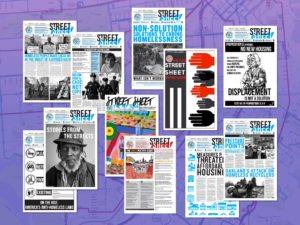You’re Needed After the Turkey
As of press time, the two major meal programs in the Tenderloin—St. Anthony Foundation and Glide Memorial—are no longer accepting volunteers for cooking on Thanksgiving.
Thanksgiving—as many staff from social services will know—is one of the two most popular days in the year for volunteering. In the emotional calendar of US holidays, the winter holidays bring out some of what is best in us: generosity (many organizations receive the bulk of their donations in December),
Whose Mayor?
In the November 3 election, incumbent Ed Lee won reelection for Mayor of San Francisco. This was hardly a surprise—most newspapers in town acted as though the Mayor had no rivals. (In fact, there was a team of candidates urging a “1-2-3: Anyone but Lee” vote, taking advantage of San Francisco’s ranked choice system to collaborate with one another rather than compete.)
While hardly anyone expected that Lee wouldn’t win, it’s a little surprising how little of the vote he got.
A Matter of Priorities
By Louise Andersen
The Coalition on Homelessness gathered a great group of people on Market Street on a cloudy Thursday afternoon. Around 100 people gathered in front of the Westfield Mall to draw attention to the issue of homeless families and children in San Francisco. There are currently 3,300 homeless children in the city—that’s enough children to fill 70 classrooms.
Sheltered in New York
By Kat Calloway
Governed by a unique right to shelter mandate, New York City provides temporary emergency shelter to every man, woman, and child who is eligible for services, every night. This policy sets New York apart from municipalities across the nation—many of which turn homeless individuals and families away once shelters have filled up or simply put their names on a waiting list. NYC shelters a staggering 60,000 a night, with another estimated 6,000 choosing the street over the shelter experience.
Playing Politics with Tragedy
Día de los Muertos altar at the Coalition on Homelessness
Please note: This article addresses the violent deaths of several individuals our communities have lost this past year. As such, it may not be an appropriate article for younger readers. Those who have lost loved ones to violence may find this article hard to read. Our hearts are with all those who have experienced such loss. May your roads get easier and your burdens lighter with the passage of time.
An Agenda for the Next Homeless Director
By Jennifer Friedenbach
Outgoing Director of HOPE Bevan Dufty (second from left) with Supervisor David Campos (left), Laura Guzmán of the Mission Neighborhood Resource Center, Brian Bassinger of the AIDS Housing Alliance, Director Trent Rhorer of the Human Services Agency, Wendy Phillips of Dolores Street Community Services, and Mayor Ed Lee (right) at the opening of Jazzie’s Place—the United States’ first adult LGBT homeless shelter.
A version of this story first appeared on October 19 on the fantastic news website 48 Hills.
Yes on I: Moratorium on Market-Rate Housing in the Mission
YOU SHOULD KNOW:
Affordable housing is housing that is designated below market rate.
Below Market Rate: BMR units are priced to be affordable to low- or middle-income households—from 50% to 120% of the Area Media Income or AMI. These units will generally rent for 55% of the AMI and/or sell for 90% of the AMI.
Middle-Income Household: A household whose combined annual gross income for all members is between 120% and 150% of the AMI,
Marc Garcia: 1954–2015
On October 1, the Coalition on Homelessness and the Street Sheet lost a vital member of our community, Marc Garcia. Marc was unfailingly kind, and consistently righteous. Marc was a behind-the-scenes, never-in-the-limelight but vital part of our organizing and community.
Marc started with us more then a decade ago, volunteering with the Right to a Roof workgroup—a group comprised mostly of homeless people who were working on improving conditions in San Francisco’s then-brutal shelters,
SRO Census Released
by Louise Andersen
Single-room occupancy hotels are one of the last remaining affordable housing options for San Francisco’s most vulnerable and low-income residents. In the SROs live families with children, immigrants, victims of domestic violence, the elderly, and individuals with special needs or disabilities, as well as a large number of people working hard but unable to afford decent housing.
The SRO Families United Collaborative—which is an organization placed in four different neighborhoods in San Francisco: Chinatown,

